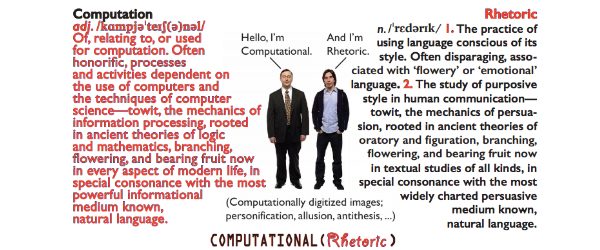All literary criticism is exemplary, but some literary criticism is more exemplary than others.
A brief introduction to the Augmented Criticism Lab, one of my current research projects.
What does that mean? In literary criticism, your textual evidence is the set of examples you choose to represent a broader pattern. Your job is to recognize and name that pattern, and then to gather enough evidence to make your argument convincing. It might begin with a local phenomenon like this melodious repetition in Shakespeare’s Sonnet 29: “Featured like him, like him with friends possessed.” The critic gives it a name (anadiplosis, in this case) before noticing a comparable pattern in the first sonnet of Sidney’s ‘Astrophil and Stella’: “Pleasure might cause her read, reading might make her know, | Knowledge might pity win, and pity grace obtain.” These anadiploses repeat in an interlocking chain of clauses, to create the pattern called gradatio – moving gradually through each stage, from reading to knowing to pitying. So you undertake a series of linear readings, collecting and comparing instances in an “ecology of critical gestures” to build an argument about how these poets use these rhetorical figures.
Gradatio arranges terms in a progression that feels natural: from A to B, B to C. Yet it’s an artificial way to compel you to follow a line of reasoning. Its writer or speaker has to arrange words deliberately, repeating them in a pattern that reels you in.
Rhetorical figures are formulaic patterns that earn our attention because they protrude from their surrounding language. There are hundreds of these patterns catalogued by classical and Renaissance readers. But readers in 2015 have an advantage: we can search texts for these patterns, and see a single figure in its multiple forms and contexts. To understand figures as a category, we need to search them out in many hundreds of texts simultaneously, and generate a list of search results to sift and interpret.
That’s one goal of a project I’m leading, the Augmented Criticism Lab: to enlarge the scope of literary criticism, to extend its exemplary case-studies to more holistic, definitive arguments.
We’re creating new knowledge about our core research questions. Can rhetoric be natural, or must it be artificial? What cognitive processes do figures reveal in speakers or provoke in audiences? We’ll address this in the next couple of years by extending our textual range (beyond Shakespeare and his contemporaries to the 70,000 English texts printed before 1700); and expanding our capabilities (beyond simple repetitions to complex variations).
We won’t replace human readers with machines; we’ll just make machines’ fast, simple queries a natural complement to humans’ slow, nuanced interpretations. Just as augmented-reality interfaces like Google Glass overlay the world with transparent layers of information like spatial coordinates, this project will overlay texts with information about their linguistic features.




